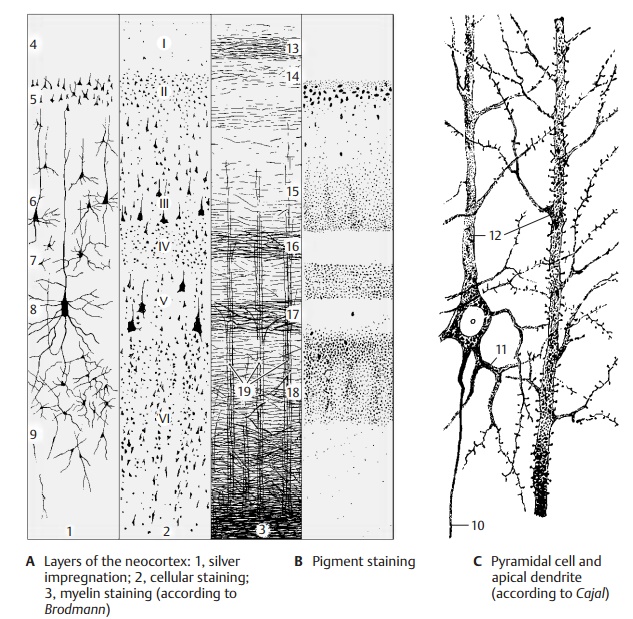Chapter: Human Nervous System and Sensory Organs : Telencephalon
Neocortex: Cortical Layers
Neocortex
Cortical Layers (A – C)
The neocortex (isocortex) exhibits a stratifi-cation into six layers running parallel to thesurface of the hemisphere. The stratification can be demonstrated by silver impregnation (A1), cellular staining according to Nissl (A2), myelin staining (A3), and pigment staining (B). The layers are distinguished ac-cording to the different shapes, sizes and numbers of their neurons and by the differ-ent densities of myelinated nerve fibers.
Cellular staining (A2) reveals the followingfeatures:
The outermost layer, the molecular layer (layer I) (A4), contains few cells.
! The external granular layer (layer II) (A5) is densely packed with small granule cells.
The external pyramidal layer (layer III) (A6) contains predominantly medium-sized pyramidal cells.
! The internal granular layer (layer IV) (A7) consists of densely packed small granule cells.
! The internal pyramidal layer (ganglioniclayer) (layer V) (A8) contains large pyra-midal cells.
! The multiform layer (layer VI) (A9) completes the stratification with a loose mixture of different cell types.
Silver impregnation (A1), which shows theneuron with all its processes, makes it possible to identify the granule cells of layer II as small pyramidal cells and stellate cells, and the granule cells of layer IV pre-dominantly as stellate cells. The pyramidal cell (C) is the typical neuron of the neocor-tex. Its axon (C10) takes off from the base of the cell, where the basal dendrites (C11) branch off at the margins. One long, thick dendrite, the apical dendrite (C12), ascends to the surface of the cortex. The dendrites have thousands of spines at which other neurons synapse.
Myelin staining (A3) of the nerve fibers re-veals the following layers based on the different densities of tangential fibers:
! The tangential layer (A13).
! The dysfibrous layer (A14).
! The suprastriate layer (A15).
! The external (A16) and internal (A17)

Baillarger’s bands of high fiber density,the external band being created by branches of afferent fibers, the internal band by axon collaterals of pyramidal cells.
The substriate layer (A18) completes the stratification.
In addition, there are the vertical bundles of radial fibers (A19).
Pigment staining (B). The various neuronsdiffer in their degree of pigmentation. The different pigment contents cause the characteristic stratification of the cortex, usually with two unpigmented bands corre-sponding to the two Baillarger’s bands.
Related Topics